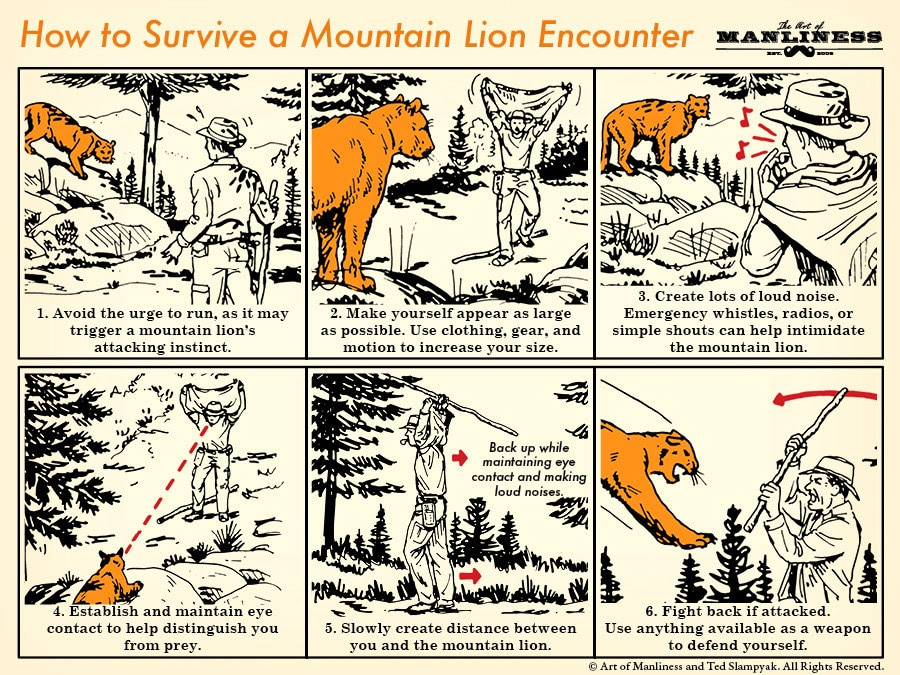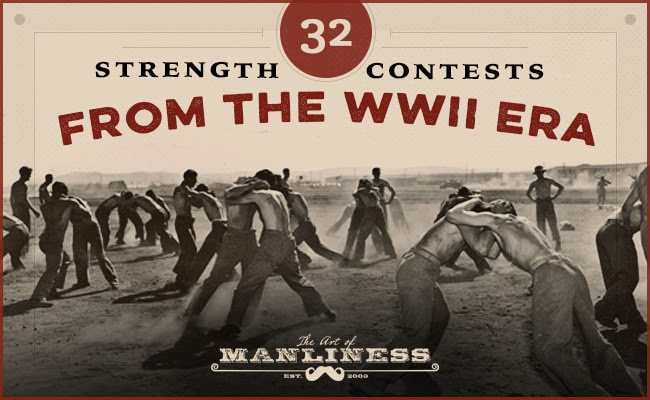
Editor’s note: FM 21-20 (1946) was the Army’s field manual for physical training, and consisted of exercises and fitness programs developed during World War II, which were then codified after its conclusion. The focus of the recommended exercises was getting men who had been living a fairly cushy lifestyle hardened up and ready to battle the Axis powers. We’ve highlighted many of these WWII-era workouts before, and today we’ll take a look at another aspect of GIs physical training: combative contests.
Combative contests were all-out, rough-n-tumble matches that tested a soldier’s strength, stamina, and “will to win.” They were designed to add some fun leaven to the more routine workouts the GIs did, like calisthenics and running, and to build the men’s competitive spirit. As FM 21-20 observes, “Because of this competitive factor, men will put in more effort than they ordinarily do in conditioning exercises.” Engaged in mano-a-mano or between teams, such contests develop “many valuable character qualities such as initiative, persistence, cooperation, confidence, [and] physical courage.”
The next time you and your buddies get together, try out some of these contests — go toe-to-toe with your bros, find out if you’re as tough as a WWII GI, and see who comes out the victor!
The Value of Combative Contests
This type of activity consists of individual and group contests of a rough and strenuous nature. The purpose of such contests is to develop aggressiveness, initiative, and resourcefulness in personal combat; to develop proper footwork and weight control; and to train the men to react violently with a maximum of energy for the purpose of overcoming an opponent. Regardless of previously developed habits in maneuvering in such contests, the men should be instructed to attempt to over-throw the opponent at once. Hence, in these contests, every man is trained to give his all. Defeats suffered in early practice will be compensated for by habits of aggressiveness and by the quick and adaptive thinking which grow from such practice.
Contests – Individual Competition
1. Pull-Hands

Establish three parallel lines 10 feet apart. The men are paired so they face each other about 3 feet apart, both equally distant from a middle line. They grasp each other’s wrists. At the starting signal, each man attempts to pull his opponent back across his base line. Any contestant pulled across his opponent’s base line is loser. After a predetermined time, any player pulled across the middle line is also the loser. If the hands become separated, they are rejoined at the point of separation as in the beginning. The contestant who first wins three bouts is the winner.
2. Hop and Pull-Hands
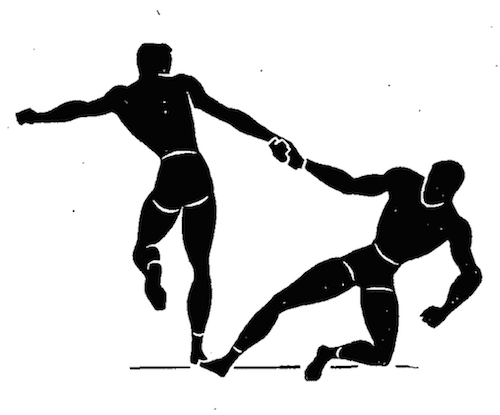
The men are matched in pairs. Each man grasps his opponent’s right hand, and hopping on his right foot, attempts to pull his opponent over the middle line. Either contestant automatically loses if he touches his rear foot to the ground. The contestant who first wins three bouts is the winner. On successive bouts, they alternate hands and feet.
3. Back-to-Back Push
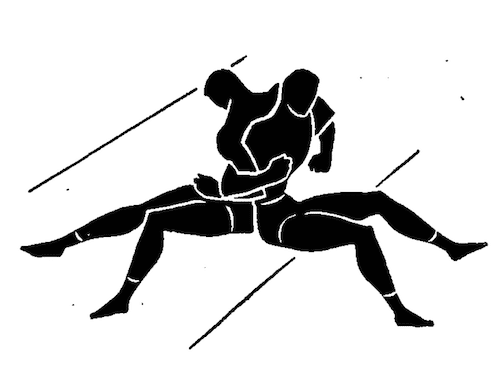
Two contestants stand back-to-back with elbows locked. Each contestant has right arm inside opponent’s left arm. A base line is established 10 feet in front of each contestant. At the starting signal, each, by pushing backward attempts to push the other over his (the opponent’s) base line. The contestants are not allowed to lift and carry their opponents. Pushing only is permitted. A contestant pushed over his own base line loses the bout. The contestant who first wins three bouts is the winner.
4. Back-to-Back Tug
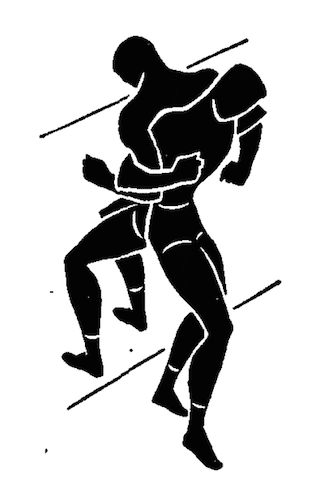
Two contestants stand back to back with both arms linked at the elbows. Each contestant has his right arm inside opponent’s left arm. A baseline is established 10 feet in front of each contestant. At the starting signal, each attempts to drag the opponent over his baseline. Lifting and carrying are permitted. Contestants must maintain original positions with arms linked. Either contestant carried across his opponent’s baseline loses. After a predetermined time, the player carried the farthest is also the loser. The contestant who first wins three bouts is the winner.
5. Back-to-Back, Arms Between Legs

Contestants are paired off, back to back. A baseline is established 10 feet in front of each man. Each bends forward and, extending his right arm between his legs, grasps his opponent’s right wrist. At the starting signal, each attempts to pull his opponent across his baseline. After a predetermined time, any player who has pulled his opponent over his baseline or over to his side of middle line is the winner. Repeat with left hand and then both hands. The contestant who first wins two bouts is the winner.
6. Knock Them Down
At starting signal, each man attempts to knock opponent off his feet in any manner he chooses. He may tackle, push, pull, lift, or wrestle. First man who has any part of body except feet touching ground loses.
7. Step On Toes
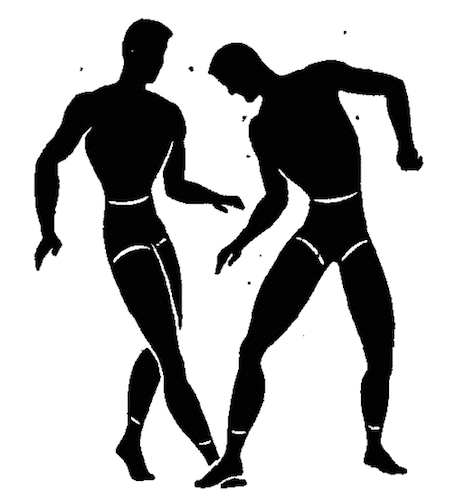
The men are paired off. At starting signal, each man attempts. to step on toes of his opponent. Activity continues until the stop signal. This is a vigorous activity if continued for about a minute.
8. Arm Lock Wrestle
The contestants sit on the floor, back to back, with legs spread and arms locked at the elbows. Each contestant has his right arm inside his opponent’s left arm. At the starting signal, each endeavors to pull his opponent over to the side so that his left arm or shoulder touches the floor. The contestant who first wins three bouts is the winner.
9. Wrestling from Referee’s Hold
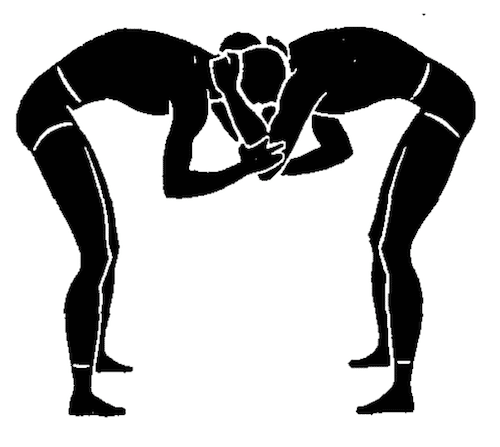
The men assume what is known in wrestling as the referee’s hold. Each contestant grasps back of opponent’s neck with left hand and opponent’s left elbow with right hand. In this position each man attempts to pull or push his opponent across a line or out of a circle.
10. Bulling
The men assume the referee’s hold, each grasping opponent’s neck with left hand and opponent’s left elbow with right hand. Each attempts to force his opponent to move one foot by pushing, pulling, or otherwise manipulating him.
11. Rooster Fight
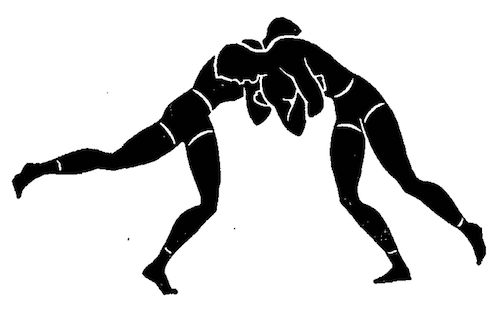
Each contestant, with arms folded across chest, hops on right foot. He uses right shoulder and right side of chest to butt his opponent. The object is to make his opponent lose his balance and fall, to unfold his arms, or to touch his free foot to the ground. The contestant who first wins three bouts is the winner.
12. Rooster Fight (Alternative)
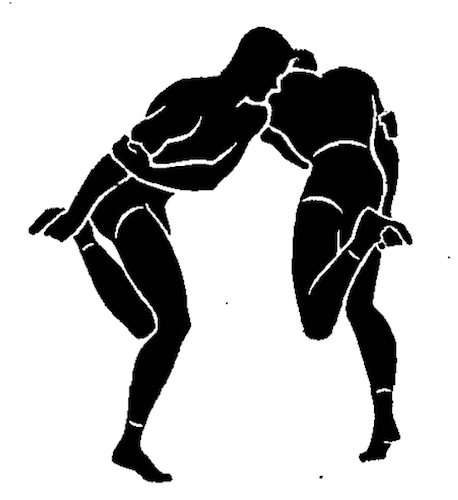
Each contestant grasps his left foot with right hand from behind, and right arm with left hand. He hops on his right foot, and by butting his opponent, or by feinting and sudden evasions, forces him to let go of foot or arm. (The name is derived from the position of left leg.)
13. Stick Pull
Three parallel lines are established 10 feet apart. Two men grasp a wand, stick, or softball bat with both hands. Starting at the middle line, each man attempts to pull his opponent over his base line. The contestant who first wins three bouts is the winner.
14. Pull-Stick Tug-of-War

Two men are seated on the ground with soles of feet in contact. Each contestant grasps a stick or softball bat so that it is directly over their feet. At the starting signal, each contestant tries to pull his opponent from sitting position to feet.
15. Stick-Twist
With right palms upward and left palms downward, both contestants grasp a wand or softball bat. Upon the starting signal, the contestants try to twist the stick to the left, or counter-clockwise. After several bouts of this nature, the position of palms is changed, and the stick is twisted to the right, or clockwise. The contestant who first wins three bouts is the winner.
16. Stick-Wrestle
With right palms upward and left palms downward both contestants grasp a wand or softball bat. At starting signal both wrestle for the stick, attempting to take it away from the opponent by any means.
17. Wrist-Wrestling
Two men lie on backs, side by side, and head to feet, in such a position that the insides of right (left) elbows are side by side; fingers are interlocked; feet are spread and other arm is by side. Each man tries to press his opponents’ wrist down over against his own side. The contestant who first wins three bouts is the winner.
18. Hand-Wrestling
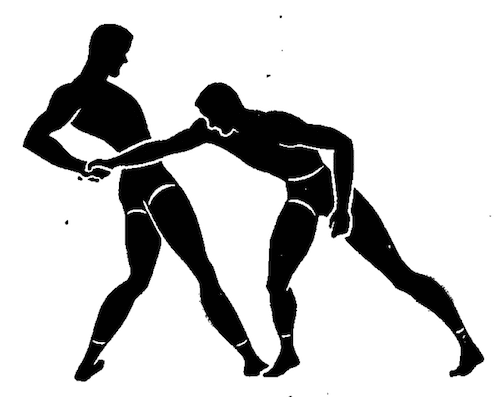
The men stand facing each other. Right feet are forward and braced side by side. The men grasp right hands on the first bout (left in second bout, etc.), with little fingers interlocked. Each attempts by pulling, pushing, making a sideward movement, or otherwise maneuvering to force his opponent to move one or both feet from the original position. The contestant who first wins three bouts is the winner.
19. Harlequin Wrestling
Each man stands on his left (right) foot, holding his opponent’s right (left) hand. The object is to overbalance the opponent or to force him to put his free foot to the ground. Pushing with shoulders is not permitted. A modification of this contest is to hold free foot with free hand.
20. Indian Wrestling

Two men lie on the ground, side by side, with heads in opposite directions. They link right elbows. Upon the signal of the instructor or by mutual agreement, each man raises his right leg, with knee approximately straight, far enough to engage heel of his opponent. To time the contest, each man usually raises his leg three times rhythmically, and the third time engages the opponent’s heel, attempting to roll him over backward. The right leg is used for three bouts, then the left leg for three bouts.
21. Wrist Bending

Opponents pair off and face each other; raise arms forward; and with palms up, lock fingers. At the starting signal, each man attempts to bend his opponent’s wrist. The hands are brought downward between contestants. The man winning three bouts first, is the winner.
22. Wrestling to Lift Off Feet
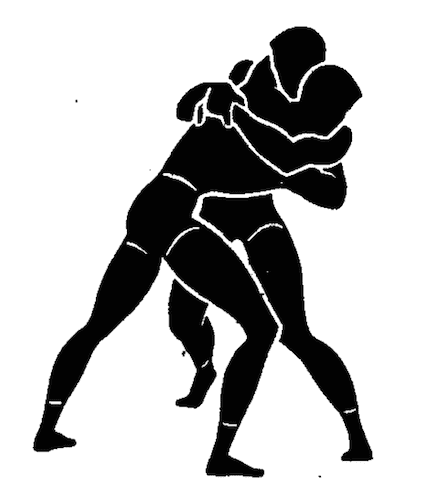
The contestant maneuvers to grasp the opponent with front or rear waist-hold, and to lift him off his feet.
23. Wrestling
Each man tries to force his opponent to touch the ground with some other part of his body than his feet.
Contests – Group or Team Competition
1. Bull in Ring
No equipment needed. Group forms in a circle holding hands. One man, termed the “Bull,” is placed in the center. If there are more than 20 men in the ring, there are two “Bulls.” The “Bull” tries to break out by charging the ring so the clasped hands are forced apart. If the “Bull” gets out, he immediately tags another player who becomes “Bull.” This game may be played by two teams, each of which forms a circle. An opposing player is the “Bull” in each circle. At the starting signal each attempts to break out by going over, under, or through. The first man to break clear wins a point for his side. The contest continues until each man has been a “Bull” in his opponents’ circle.
2. Ring Push

Players are divided into two clearly designated teams, both of which enter a large circle. At the starting signal, players of each team attempt to push all opponents out of circle. Players forced from the circle are eliminated. All players must keep arms folded across the chest throughout. The contest continues until all the members of one team are eliminated.
3. Ring Push (Sitting)
This activity is performed in the same manner as #2 above. However, all men are seated on the ground, back to back.
4. Line Charging
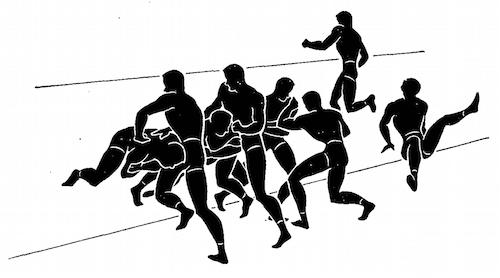
Two teams form lines facing each other about 1 foot apart. The players of each team are 1 foot apart. A line is established 10 feet behind Team “B.” At the whistle, team “A” attempts to break through the line of team “B.” Team “A” may use its hands; team “B” may not. The players of team “B” usually assume a crouched position. After 3 to 5 seconds (usually 3 at first, 5 seconds later), the referee blows his whistle and counts the number of men who have broken through the opponent’s line and reached the baseline. The team which has the greatest number of contestants reach the baseline in three attempts wins. Indoor competition may be conducted on a string of mats.
5. Island
The players are divided into two distinctively marked teams. The teams line up on opposite sides of an area approximately 10 feet square. At the starting signal, all players rush forward to the middle of the area where they attempt to remain. The players attempt to throw their opponents out of the area. If a player is forced from the island he may return if he can before the contest is terminated. The team having the greatest number of players on the island at the end of 2 minutes wins the game. Indoors a mat may be used as the island.
6. Catch and Pull Tug-of-War
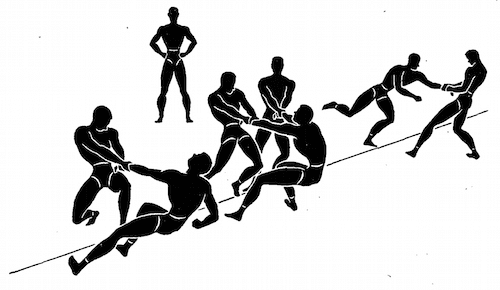
Two teams line up on either side of a line on the ground. The men attempt to grasp an opponent’s hand or wrist and pull him across the line. Two or more of one team may gang up on one opponent. When an individual touches the ground on the other side of the line, he retires to the rear of his captor’s territory as a prisoner. The contest continues until all men of one team have been pulled across the line. If any men refuse to approach closely enough to engage their opponents, the referee declares them defeated. Such practices should be discouraged, however. As a variation, those pulled across the line may join with their opponents in attacking former teammates continuing until no one is left on one side.
7. Goal Line Wrestling

This activity is performed similarly to #6 above except that a line is drawn 15 feet behind each team and when a player is carried or pulled across line behind his opponent’s side, he is declared “dead” and out of competition.
8. Horse and Rider Fights
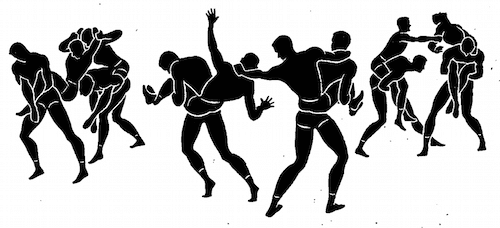
Players are divided into two teams and paired off. One player of each pair sits astride the hips of his partner and locks his feet in front. At the starting signal, the “horses” move forward so that the “riders” can reach each other. Each “rider” attempts to overthrow an opponent. The “horses” are not allowed to help the “riders.” The “riders” are allowed to use all fair wrestling tactics; they are not allowed to interfere with the “horses.” The “rider” who touches the floor in any way, either forced down from his “horse” or overthrown with his “horse” first loses. Last team up is the winner. This contest should only be conducted where it is not dangerous to fall.
9. Human Tug-of-War
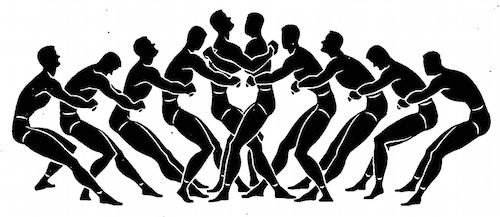
Two teams line up in two columns facing each other. Team members stand close together. Each man places his arms about the waists of the men in front of him (grasping his own left wrist with his own right hand is the strongest grip). The leading man of each team grasps his opponent about neck and shoulders. The team breaking first or having one or more men pulled over the line separating the two teams after 30 seconds is the loser.
